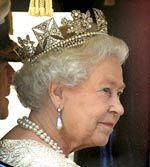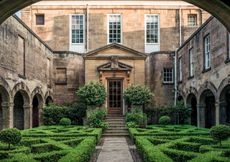The Queen's Diamonds
Country Life takes a look at Elizabeth's magnificent collection of diamonds


For centuries, diamonds have been worn by kings and queens to symbolise rank. These most precious and beautiful works of nature convey the aura of majesty-Shakespeare's ‘such divinitie doth hedge a king'-more effectively than any other precious stone. Elizabeth II's diamonds, inseparable from her image, belong to one of the world's greatest collections. How appropriate, then, that her Diamond Jubilee is to be marked by an exhibition of some of her wonderful stones.
The beautiful colours of the sapphire, ruby and emerald are lost when seen in the distance, but the diamond, by absorbing the light and then reflecting it with brilliance and intensity, draws the eye with lightning speed so that the wearer stands out, however great the crowd. Aware of its power, the Tudor and Stuart rulers of England acquired diamond jewellery regarded by their subjects as a source of national pride and glory.
This tradition of magnificence came to an end with the Civil War, when the best Golconda diamonds-Elizabeth I's Mirror of Portugal and the Sancy of James I-were lost to Cardinal Mazarin in France, after having been pledged as security for unredeemed loans. Recovery was slow, and it was not until the reign of George III that the jewels of an English ruler could compare once again with those of Continental royalty.
Unfortunately, many of these, including the famous Arcot and Hastings diamonds, were dispersed on Queen Charlotte's death in 1818. Worse was to come, for, after Queen Victoria's Coronation in 1838, ownership of the stones she had inherited from her uncles George IV and William IV was contested by their brother, Ernest, King of Hanover. The dispute continued for more than 20 years and was finally decided in his favour in 1857, so that Queen Victoria had to assemble another collection almost from scratch.
However, after R. & S. Garrard had remounted diamonds from the ceremonial swords and Garter insignia of George III and her uncles, she was left with enough to make such a good show that her appearance at the wedding of her eldest daughter, Princess Victoria, to the German Prince Fried-rich in 1858 was applauded by the Illustrated London News: ‘We feel proud that our judges learned in the law have not awarded every jewel we possess to the Hanoverian monarchs.'
For the rest of Queen Victoria's reign, generous gifts were offered to supplement what remained to her. The most important came from the treasury of Lahore, annexed by the East India Company when the Pun-jab was brought under British rule in 1849. The company gave her fine stones and pearls, including the Timur ruby (now confirmed by gemmologists to be a spinel), and the great 186-carat diamond called the Kôh-i-Nûr (Mountain of Light), which had been prized by Moghul emperors over centuries. The Kôh-i-Nûr, cut to 106 carats, was set into the Coronation crown of Queen Elizabeth in 1937 and can be seen in the Jewel House of the Tower of London.
The tiara, which, more than any other jewel, signifies rank and prestige, is essential for many other royal occasions. As the Lady's Magazine observed in 1799: ‘How can a lady of the most illustrious descent awe the humble spectator into reverence if a mere silken fillet binds her hair?' The Queen has a large collection from various sources, each with a different story to tell. Outstanding are her two fringe tiaras, which echo the halo-shaped headdress, or kokoshnik, worn at the Russian Court.
Sign up for the Country Life Newsletter
Exquisite houses, the beauty of Nature, and how to get the most from your life, straight to your inbox.
The earliest was adapted from a necklace made in the 1830s for Queen Adelaide and the other was inherited from Queen Alexandra, to whom it was given by friends in 1888 to mark her 25th wedding anniversary. The stately tiara created by Bolin of Russia for the formidable Grand Duchess Vladimir was acquired by Queen Mary in 1921. It is composed of interlaced diamond circles, which can be hung with the Cam-bridge emerald drops or with pearls -diamonds have the power of enhancing colour and marry perfectly with the soft iridescence of pearls. Quintessentially Victorian is Queen Mary's light openwork spike, festoon and scroll tiara, which appears more frequently than the others and must, presumably, be easy to wear.
The Queen has so many diamond brooches they could fill a volume, and each, pinned to the shoulder of a day or evening dress, makes a statement. There are the bowknots, always worn with 18th-century Court dress, some with patterned ribbons, others plain; the ears of corn, symbolic of prosperity; and the bar brooches, consisting of lines of stones and useful for keeping the Garter sash or scarf in place. Pride of place, however, must always go the brooches created from stones III, IV, V, VII and VIII cut from the remains of the Cullinan diamond.
The Queen's arms and hands are always so much in evidence at official events, with diamond bracelets and rings providing brilliance to her wrists and fingers. The earliest is a pair of four-row diamond bracelets fastened with clasps enamelled blue and bearing the diamond ciphers of William IV and Queen Adelaide. She also has a pair of traditional Indian bangles and various flexible band bracelets of Art Deco pattern mounted in platinum. As for her rings, a solitaire was given to her by Prince Philip on their engagement in 1947.
The indestructible diamond is emblematic of majesty, but it also symbolises enduring sentiment.
‘Diamonds: A Jubilee Celebration' will be at Buckingham Palace from June 30 to July 8, and from July 31 to October 7 (020-7766 7300; www.royalcollection.org.uk).
The Queen's Diamonds by Hugh Roberts is available from Royal Collection Publications (£60)
to Country Life and save £1 per week
Country Life is unlike any other magazine: the only glossy weekly on the newsstand and the only magazine that has been guest-edited by HRH The King not once, but twice. It is a celebration of modern rural life and all its diverse joys and pleasures — that was first published in Queen Victoria's Diamond Jubilee year. Our eclectic mixture of witty and informative content — from the most up-to-date property news and commentary and a coveted glimpse inside some of the UK's best houses and gardens, to gardening, the arts and interior design, written by experts in their field — still cannot be found in print or online, anywhere else.
-
 Can't you hear me S.O.S? Our treasured native dog breeds are at risk of extinction
Can't you hear me S.O.S? Our treasured native dog breeds are at risk of extinctionDo you know your Kerry blue terrier from your Lancashire heeler? A simple lack of publicity is often to blame for some of the UK's native dog breeds flying dangerously low under-the-radar.
By Victoria Marston Published
-
 'There are architects and architects, but only one ARCHITECT': Sir Edwin Lutyens and the wartime Chancellor who helped launch his stellar career
'There are architects and architects, but only one ARCHITECT': Sir Edwin Lutyens and the wartime Chancellor who helped launch his stellar careerClive Aslet explores the relationship between Sir Edwin Lutyens and perhaps his most important private client, the politician and financier Reginald McKenna.
By Clive Aslet Published
